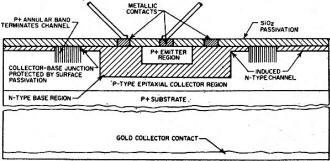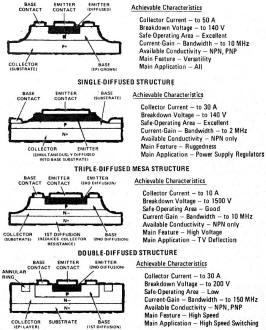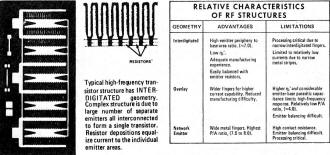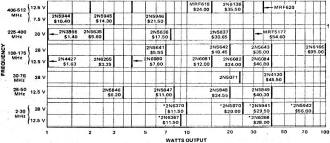Do You Know Your Bipolar Transistors? - Part 3
|
|
Mr. Lothar Stern, of Motorola Semi, published a 3-part series on transistor theory in Popular Electronics magazine in 1973. This is part 3. Part 1 introduced the basics of the bipolar transistor, and Part 2 addressed transistor circuit configurations - common emitter, common gate, common collector, Darlington, differential - as well as presenting gain equations and delving a bit into the physical construction of the semiconductor elements. Finally, the author talks about the newest processes in use at the time and what was available for low power and high power RF applications. In 1973, high power semiconductors were just pushing past the 100 MHz barrier. Gallium arsenide (GaAs) and gallium nitride (GaN) were still in university and corporate laboratories being prepared for the amazing devices we have powering today's wireless products. Here are Part 1, Part 2, and Part 3 (thanks to Jeff, KE5KQJ, for providing a copy of Part 3). Do You Know Your Bipolar Transistors? - Part 3 Conclusion of a 3-Part Series on Basic Transistor Theory By Lothar Stern, Motorola Semiconductor Products Inc. Newer Processes. Among new techniques, the latest process (see Fig. 15) diffuses controlled-geometry base and emitter regions into the collector layer and covers the entire device with a protective coating of silicon dioxide to eliminate impurity contamination. It permits operation at extremely high frequency, high voltage, and high current and provides good reliability at low cost. For small-signal, low-frequency transistors, the epitaxial planar structure with annular ring is, by far the most widely used. For high-power applications, however, other processes are often employed to optimize characteristics needed for special requirements. Figure 16 shows the most common power-transistor processes. Fig. 16 - Cross sections of the processes employed in making transistors for power applications, with some characteristics. EPI-Base Structure, Single-Diffused Structure, Triple-Diffused Mesa Structure, Double-Diffused Structure At very high frequencies, power transistors take on very complex geometries to compensate for current crowding. The latter restricts the emission of charge carriers to the edges of the emitter at high current levels. With rectangular or round emitters, therefore, the center portion of the emitter does not contribute to current emission, but it does add parasitic capacitance which reduces high-frequency response. High-frequency structures, therefore, have very long, thin emitters which may be folded many times to fit within a given base area. (Fig. 17) This greatly increases the ratio of emitter periphery to base area, thereby maximizing the emission-to-capacitance ratio. These extremely complex structures stress present processing technology to its limits, accounting for the rapid increases in prices as frequency capabilities of power transistors go beyond 100 MHz. Typical high-frequency transistor structure has Inter-Digitated geometry. Complex structure is due to large number of separate emitters all interconnected to form a single transistor. Resistor depositions equalize current to the individual emitter areas. Table I - Small-signal transistor capabilities. Table II - Low-frequency device capabilities Transistor Capabilities. For small signal applications, today's transistors cover virtually every conceivable requirement. Darlington (compound-connected) transistors offer high input impedances and betas up to 75,000 at audio frequencies. Amplifiers for r-f, oscillator, and mixer applications run well into the GHz band. For special applications, low-noise transistors with noise figures around 2 dB are common, and for high-voltage applications, devices with ratings up to several hundred volts are no longer unique. And, due to plastic packaging, prices are so low that there are few device capabilities that can't be purchased for under $1.00 even in unit quantities, (See Table I.) Low-Frequency Power. Power transistors for the lower frequencies are also plentiful, but do not yet fill the desired applications as completely as do the small-signal devices. (See Table II.). Prices are quite low for plastic packaged devices rated up to 15 A and about 100 W. At currents below 5 A, even some of the metal packaged devices are inexpensive. But prices rise rapidly at higher current and voltage levels, particularly if higher frequency operation is required. Considerable room for further development still exists. Fig. 17. At very high frequencies, power transistors take on some very complex geometries to compensate for current crowding. Characteristics of structures are at right. High-Frequency Power. At very high frequencies, the power picture is still more limited. Power outputs of one to five watts are available up to 1 GHz, with up to 50 watts at 500 MHz and 100 watts in the 150-MHz region. Prices remain high at the upper limits of power and frequency. Fig. 18 - Range of transistor power available for given frequency and supply voltage. R-F Power. Figure 18 shows the range of transistor power commonly available for a given frequency and power supply voltage. Specific device types have been included to suggest possible choices for a particular application. The power supply voltages given are those most usually encountered in practice. Devices are tailored for best operation at these voltages. Using a transistor with a higher than necessary voltage rating can result in performance degradation.
Posted August 29, 2018 |
|





